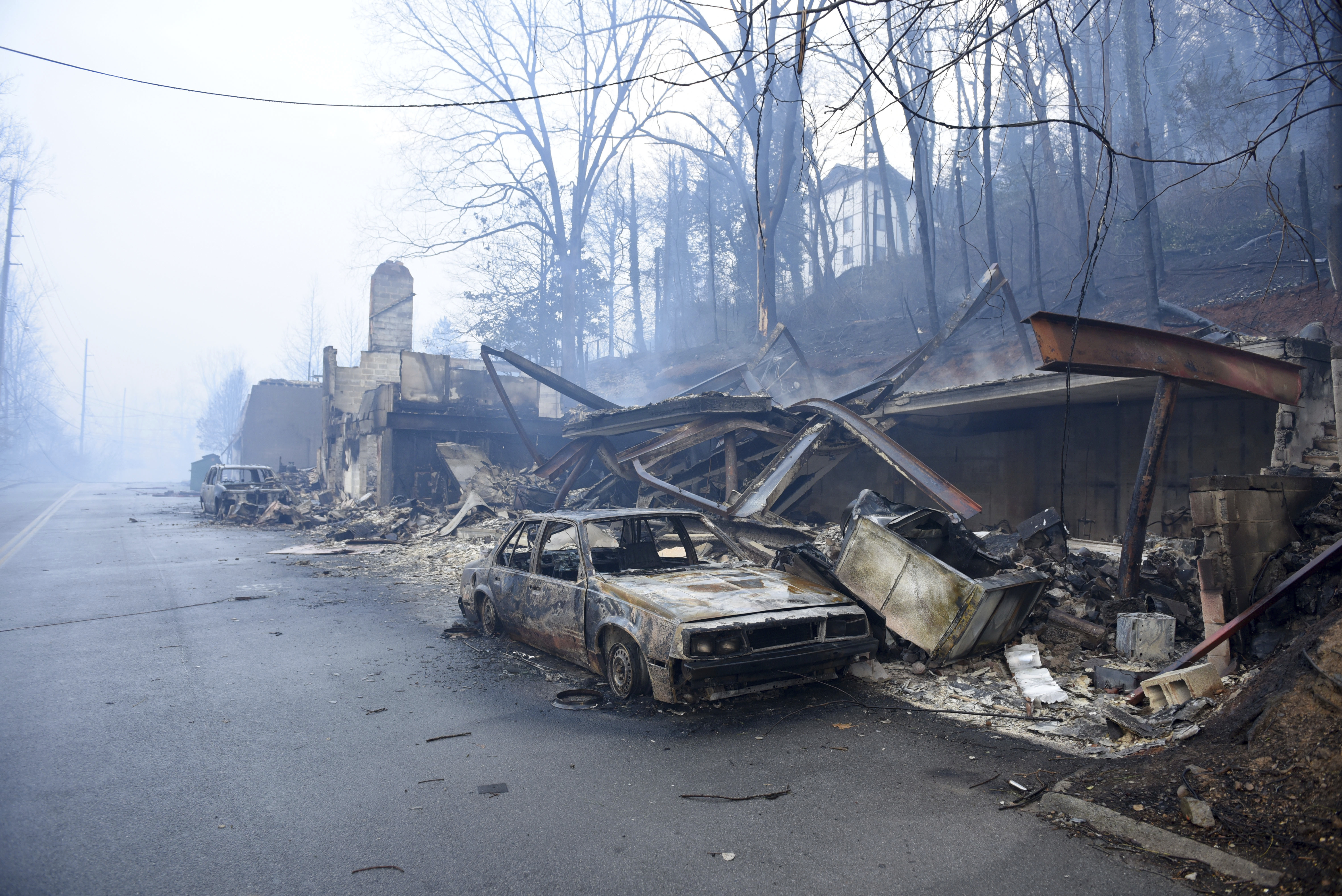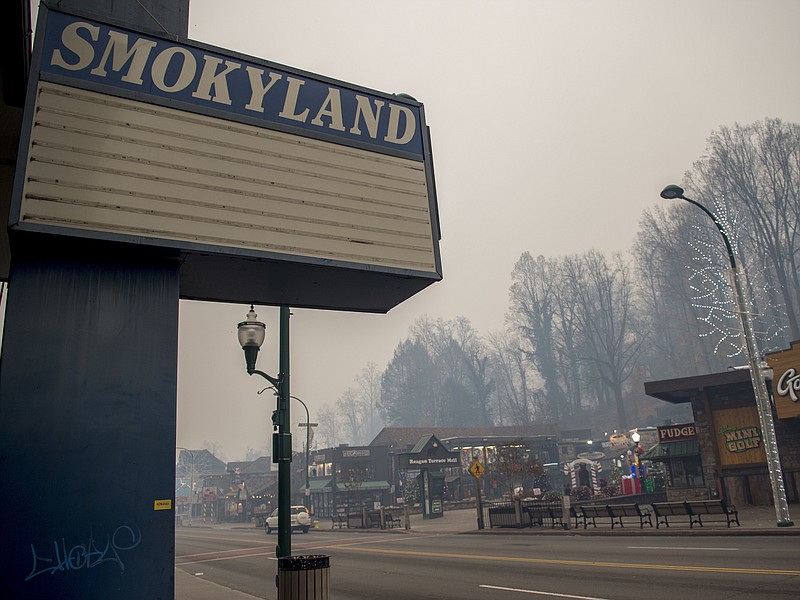 A structure and vehicle are damaged from the wildfires around Gatlinburg, Tenn., on Tuesday, Nov. 29, 2016. Rain had begun to fall in some areas, but experts predicted it would not be enough to end the relentless drought that has spread across several Southern states and provided fuel for fires now burning for weeks in states including Tennessee, Georgia and North Carolina. (Michael Patrick/Knoxville News Sentinel via AP)
A structure and vehicle are damaged from the wildfires around Gatlinburg, Tenn., on Tuesday, Nov. 29, 2016. Rain had begun to fall in some areas, but experts predicted it would not be enough to end the relentless drought that has spread across several Southern states and provided fuel for fires now burning for weeks in states including Tennessee, Georgia and North Carolina. (Michael Patrick/Knoxville News Sentinel via AP)Gatlinburg's challenge to rebuild is testament to the power of wind, fire and climate change.
Strong gusts - one official cited an 87 mph hurricane-force gust - scattered burning embers across long distances, starting fires that fed off drought-stricken trees. The winds also knocked down power lines, igniting new fires, according to authorities.
"Everything was like a perfect storm," said Cassius Cash, superintendent of the Great Smoky Mountains National Park, to a news cameraman and affiliate of CNN.
At the worst moments of the wildfire Monday night and Tuesday morning, 14,000 people were under a mandatory evacuation order from one of Tennessee's long-time resort areas.
The order came none too soon. Not only were countless acres of beautiful Tennessee forests gone - claimed by at least 14 fires - but also half of Gatlinburg. And three lives. Another dozen or so people were injured, including some with severe burns.
Mayor Mike Werner, in a televised news conference, said more than 100 structures in more than half of the town's 10-square-miles were damaged.
"Gatlinburg is a very strong, very resilient community. We will rebuild, and we will remain the premier resort community that we are. It will be OK," he said.
There can be few Tennesseans - few in the eastern half of the nation, probably - who have not vacationed, honeymooned or shopped in Gatlinburg and Pigeon Forge while visiting the Great Smoky Mountains.
But today much of what we saw in those tourism meccas will have to be made new again, including a 16-story hotel, entertainment sites and an apartment complex that was consumed by flames. As of Tuesday afternoon, it appeared Dollywood and Ripley's Aquarium had been spared.
Gatlinburg is just the latest site of the scores of wildfires we've been watching flash across the Southeast this fall - including three very near Chattanooga, two on Walden's Ridge that thankfully are now out and one still simmering in North Georgia's Fannin and Murray counties.
Monday night's rain was a huge help. WRCB Chief Meteorologist Paul Barys told Chattanooga Times Free Press reporter Ben Benton that the last time Chattanooga had gotten 1 inch of rain in a 24-hour period had been 242 days before.
Ours is an area that usually receives about 53 inches of rain a year - think of it as about an inch a week. To date, we have a yearly rain deficit of more than 20 inches. Yes, that's some severe drought - especially on the mountains and plateau. So the rain Tuesday night and this morning should provide some relief, appearing to take aim at the two largest wildfires in the South - the nearly 28,000-acre Rough Ridge Fire in north Georgia and the nearly 25,000-acre Rock Mountain Fire burning on both sides of the Georgia-North Carolina line.
Throughout the Southeast, authorities said 24 large wildfires were still burning Tuesday.
The trouble was that before those storms brought the rain, they pushed those high winds ahead of them, spreading the fires - many believed to have been started by arsonists.
Scott Stephens, of the University of California at Berkeley's Center for Fire Research, told the MSNBC's Hallie Jackson on Tuesday that climate change has long influenced the way firefighters in the west think of handling wildfires. Now, perhaps that should get more attention in the East and Southeast, as well, he said.
He noted that homeowners in the West have learned to keep vegetation further from their homes in times of drought, and perhaps that need might have to become a maxim in this region, too.
Stephens reminded us that wildfire and climate discussions are not just about weather or even safety. There's money to consider.
As the flames from the Walden's Ridge fires earlier this month edged toward homes in Boston Branch, the Federal Emergency Management Agency stepped up with a grant for a 75 percent reimbursement of costs to control the fires. FEMA has stepped up again in the Gatlinburg/Pigeon Forge fires. And in the aftermath, Stephens noted, there will be commercial insurance costs - and the resultant insurance rate increases.
Even FEMA must follow the money. Extreme weather disasters have hammered the U.S. with increasing frequency in recent years - from drought and wildfires to coastal storms and flooding. That has left FEMA caught between science and Congress. While the number of billion-dollar-plus weather disasters in the nation has increased 5 percent a year since 1980, FEMA's annual budget has stayed roughly the same, straining its ability to prepare for and respond - even with resource allocation or in the National Flood Insurance Program it administers.
Every action has a reaction.
As a community, a state, a nation and a planet, we should be careful of doing anything that stalls climate change mitigation - or denies the need to study it and base budgets on it.
It has been bad enough to see our forests burn, to see our homes threatened and to know lives are lost. We must not increase the threats.
